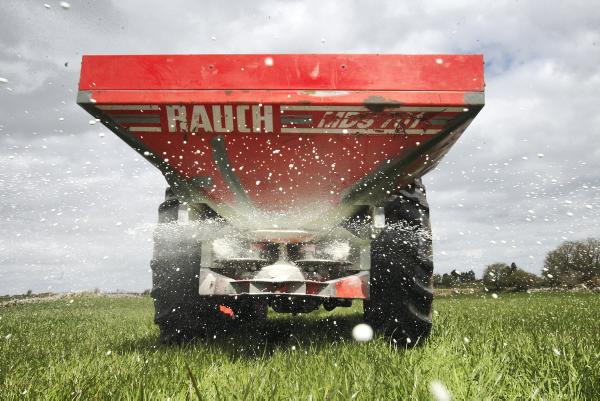Fertilizer prices are down on last month across NI and the indications are that farmers can expect a further drop in price. A lack of buying demand has seen merchants experience a lull in trade and prices are being discounted to encourage sales.
According to a number of agricultural merchants, prices were at their peak over May and June, with straight nitrogen selling from £260/t to £270/t. These prices have taken a £10/t to £15/t drop.
With bumper crops of first-cut silage and strong grass growth over the past month, farmers have been making hay and surplus bales to boost fodder supplies.
As a result, some merchants have reported lower sales of fertilizer for second-cut silage.
In some cases, dairy farmers have indicated to their merchant that they are unlikely to require a third cut. Prices stated are sold ex-yard and there are deals to be had on price, depending on volume purchased and payment option.
Straight nitrogen products are the biggest sellers to livestock farmers. CAN is moving from merchant yards at prices of £245/t to £250/t. Sulpha-CAN is also moving well and selling at a general price of £5/t more than straight CAN.
Compound NPK fertilizers have also taken a considerable price drop. Products such as 25:5:5 are down nearly £20/t from early June and are now trading around £295/t to £300/t. Other common compounds such as 20:10:10 are selling at around £315/t, with 24:6:12 selling at around £320/t to £330/t. 24:0:13 is selling from £315/t to £320/t.
Kieran Mailey
Although the start of the grain harvest is still a few weeks away, there are signals coming from the marketplace that grain prices are expected to be down this year. Northern Ireland is a net importer of grain and the market price will be heavily influenced by events elsewhere.
Dried barley in Britain is trading at around £124/t with wheat selling at £132/t. Merchants who are importing grain from Britain are forward buying at prices ranging from £145/t to £150/t.
Spot prices for local grain are few and far between. There are reports of green barley being forward-bought off the combine at £115/t to £120/t.
At these prices, local growers will be struggling to cover their cost of production and are reliant on favourable weather from now until harvest to maximise grain yields.
Straw prices are also expected to be lower than in previous years, as there appears to be increased quantities of hay in store this year across Ireland.
Straw yields are expected to be good this year given that growing conditions have been reasonably favourable this spring.
Kieran Mailey
A reduction in support for new solar photovoltaic (PV) installations from 1 April 2015 has been proposed by Enterprise Minister Arlene Foster, although support for other small-scale renewable energy projects is likely to remain unchanged.
The changes are proposed in a consultation document released by the Department of Enterprise, Trade and Investment (DETI). The consultation runs until 25 September 2014.
As part of the plans, the support for solar PV by way of Renewable Obligation Certificates (ROCs) will be cut from four to 1.6 ROCs per megawatt hour (MWh) for installations up to 50kW and from two to 1.6 for larger installations between 50kW and 250kW.
The number of solar PV installations has increased dramatically in recent years. In 2010/11, there were 227 systems in place. By 2013/14, this has increased to 3,750. The growth has mostly been in domestic installations. Over the same three-year period, the cost of solar PV has fallen by nearly 75%. According to DETI, the current level of four ROCs is too high, resulting in a 15% return on investment, where a 3% to 5% return is more appropriate.
However, recognising that some solar PV generators might not meet the 31 March 2015 deadline to accredit at four ROCs per MWh, a six-month grace period has been proposed. This only applies where grid connection has been delayed, and is beyond the control of the applicant.
Other technology
Across the other three technologies considered in the consultation – wind, hydro and anaerobic digestion (AD) – no changes are planned. While costs for AD are generally unchanged, installation costs of both wind turbines and hydro have increased significantly over the last four years. Much of the difference is due to higher costs getting connected to the electricity grid.
The higher costs could support a case for more ROCs, but DETI argues that the increase in costs has not deterred investment, particularly in wind turbines.
There are also issues to consider around the impact on the landscape and just how effective single turbines are at contributing to the overall government target to have 20% of energy consumed in NI from renewable sources by 2015. There are now 523 small-scale wind installations (under 5MW) operating in NI.
The numbers are a lot lower in hydro, with 36 generating stations and, despite a large number of applications in planning, only 13 AD plants were operational in 2013/14.
The system of ROCs is likely to be replaced on 1 April 2017 by that currently used in Britain – small-scale feed-in tariffs (FIT). Renewable energy installations in NI accredited up to 1 April 2017 will continue to receive ROCs for the full 20-year duration.






 This is a subscriber-only article
This is a subscriber-only article










SHARING OPTIONS: